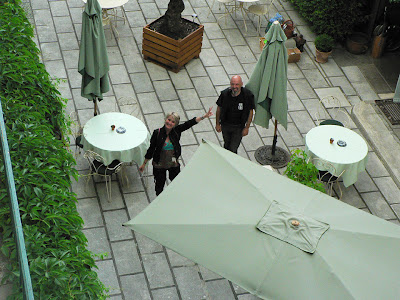The village and the ruins are on the banks of the l'Anglin River.
The gang, sans moi.
Carole, you are shooting from the wrong angle.
Some antiquities of another kind. I love the look of the old 2CV Citroens.
Looking down on the village from atop the ruins.
A closer view of the ruined chateau.
The old chapel.
Getting ready to depart Angles-sur-l'Anglin.
Oradour-sur-Glane: The Martyr Village
From the beautiful to the ugly, Laurent led us from Angles-sur-l'Anglin to Oradour-sur-Glane, site of the massacre of 642 villagers by Nazi troops on June 10, 1944, four days after D-Day. The entire village population was wiped out that day, save for one woman who escaped from the church before it was burned, by jumping from a window. The dead included 193 children. You can read a more detailed account of the massacre here.The sign below says, "Here some men offended their mothers and all the women in the worst manner: they didn't spare the children."
The French government, much to their credit, and by order of then President Charles DeGaulle, declared that the village should not be rebuilt, but should be maintained and preserved exactly as found after the massacre as a national memorial to those who died there. It is a very sobering experience to walk among the ruins and to read the plaques installed beside the doors of the burned-out buildings. They tell what the shops were and who lived and worked there.
The plaque on this wall tells us that this was a bakery operated by L. Bouchoule. The tale is told that the invaders burned Messr. Bouchoule in his own oven.
This was a garage operated by H. Desorteaux.
The main intersection of the village. The power poles were made of concrete and are still standing.
This must have been a tailor or dress shop. There were a surpising number of Singer sewing machines scattered among the ruins.
The village church where the women and children were herded and then set afire.
The plaque on the wall of the church says, "Here hundreds of women and children were massacred by the Nazis. Go to make a prayer for the victims and their families."
The only person to survive the massacre, Madame Marguerite Rouffanche, reportedly jumped from the lower right sacristry window and managed to hide in some bushes until being rescued the next day.
Another woman and child jumped with her, but were shot and killed by the Nazis.
The remains of the church bell.
The female figure atop this memorial statue is not giving thanks to God...rather, she is crying out to the heavens in anguish over the senseless massacre of the women and children of the village.





























































